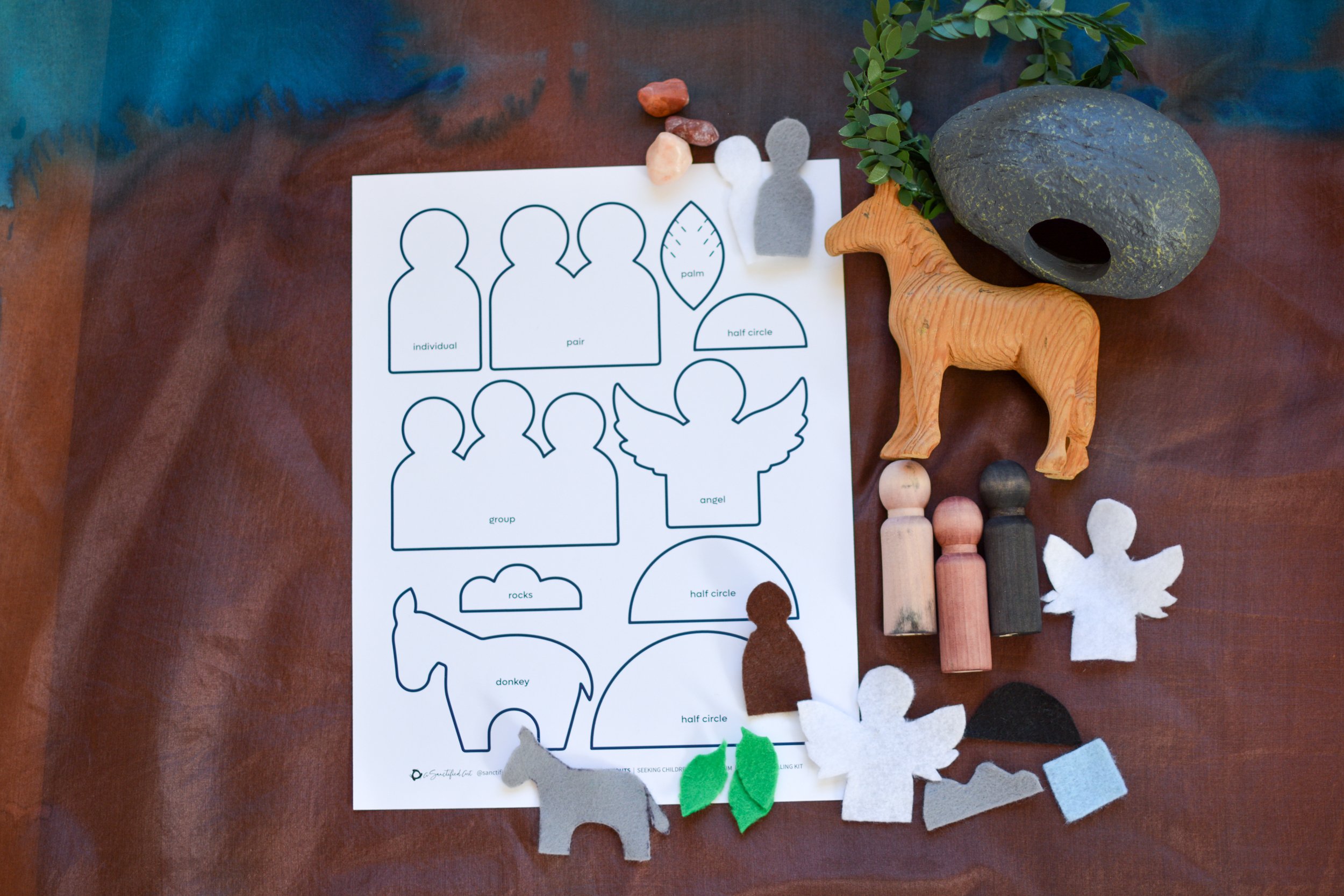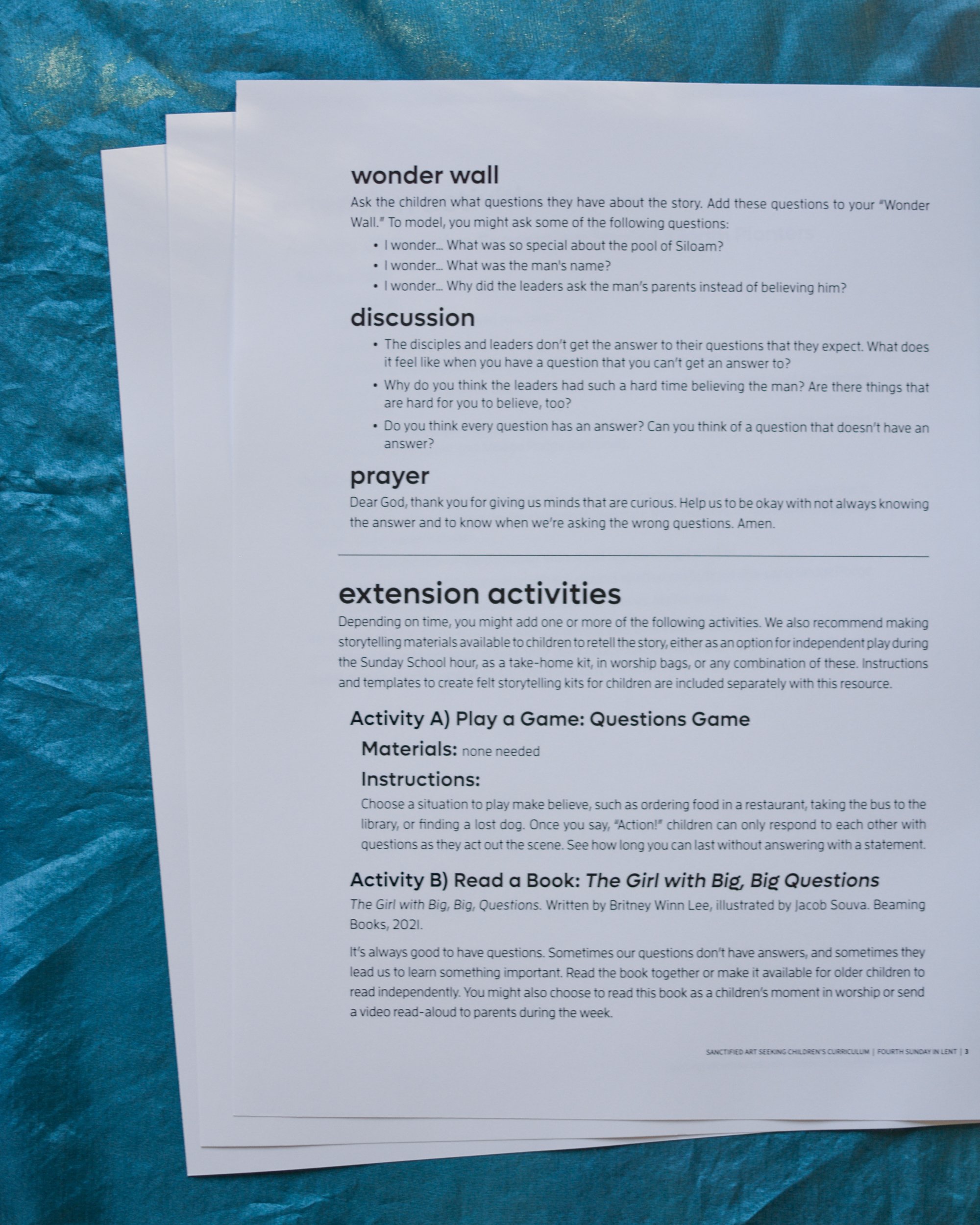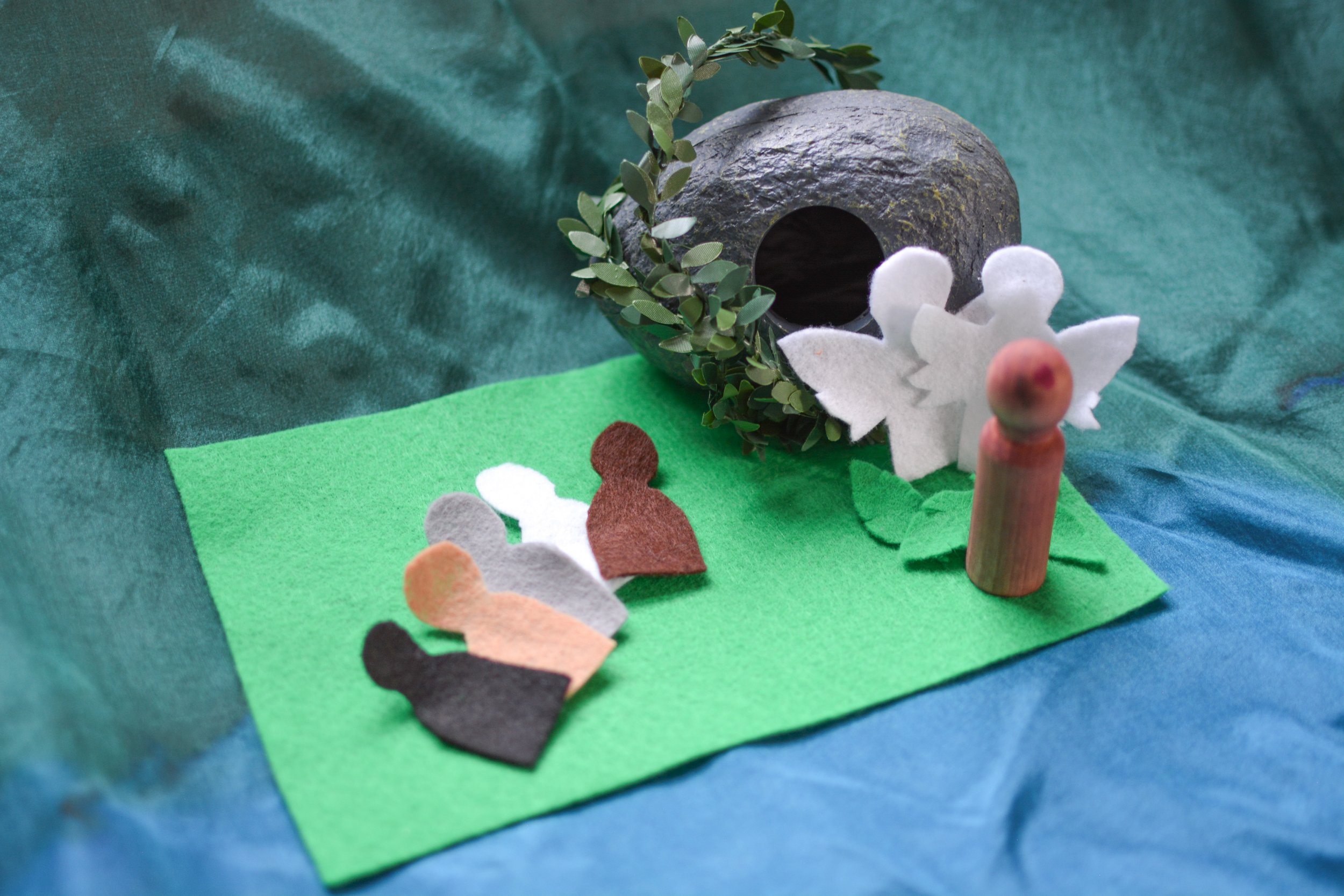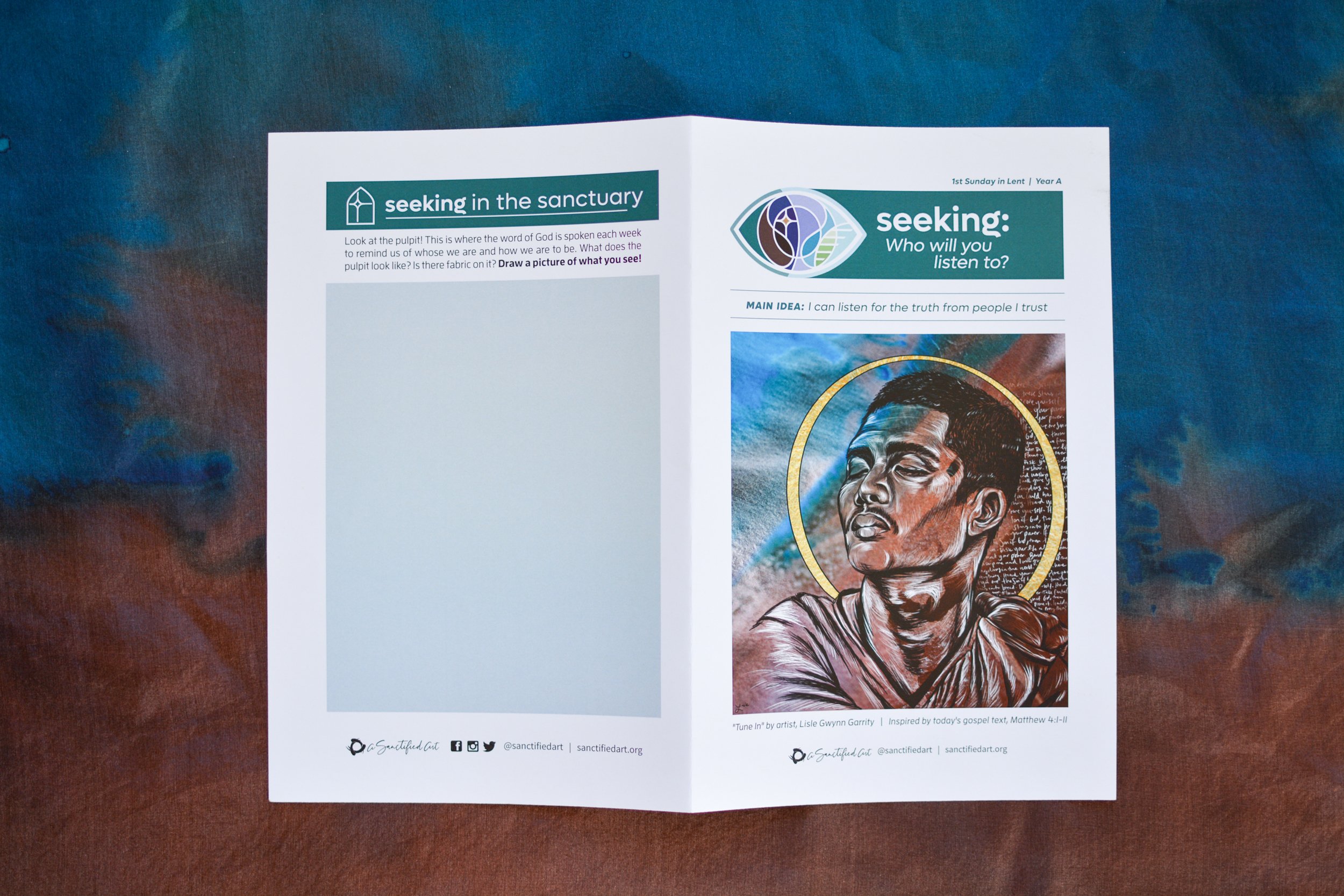Engaging Children in Worship throughout Lent
Worship has historically been a space where children are expected to be still and quiet as adults around them participate in rituals unknown to them and speak words too difficult for them to understand. Even as the church began to accommodate children—by introducing children’s moments, providing childcare during worship, and assembling worship bags—we are always seeking to further welcome children into worship in the spirit of Christ who said, “Let the little children come to me,” especially during the season of Lent. Below are ideas to integrate children into worship this Lenten season, both in setting the space and during the worship service itself. These ideas are meant to complement the new children’s resources we’ve included in our Seeking Lent bundle.
setting the stage
Worship bags
Worship bags offer an opportunity to engage children in the practices, symbols, and stories of our faith. Curating contents of the worship bags for the season, or even for each Sunday if you have the capacity, brings children deeper into liturgical rhythms and helps them make sense of what they are experiencing in worship. Some elements you might include are:
Children’s bulletins aligned with the week’s text
(See our Seeking: Children’s Bulletins for children’s bulletins that align with the Lent Year A texts)Illustrated cards showing the different components of worship—include a photograph on one side, and the part of worship (hymn, sermon, offering, etc.) on the other
Simple puzzles, such as popsicle stick puzzles, with imagery from the week’s text or liturgical symbols
(Create your own using images from our Seeking: Visual Art Collection or any image from our image licensing library related to the week’s texts)Finger labyrinths made from puff paint, string, or hot glue on laminated cards
Soft figures and objects for acting out the bible story
(See our Seeking: Children’s Curriculum for felt storytelling kit templates, instructions, and cut-out lists for the Lent Year A scriptures)Small versions of common liturgical items, such as play communion elements made of plastic, fabric, or felt
Ribbon streamers to wave during music
Blank postcards for children to decorate and drop in the offering plate for the church to send to members who are on the prayer list or confined to their home
Simple sermon outline with words or phrases to listen for
Coloring pages aligned with the theme or text and colored pencils or crayons
(See our image licensing library for colorable images)Wax sticks or pipe cleaners and laminated templates of liturgical symbols
This blog post from Building Faith (a ministry of Virginia Theological Seminary) is an excellent resource for creating worship bags that engage children in the act of worship rather than keeping them entertained. You can find additional ideas and links to helpful resources there, as well as a wealth of resources for engaging children in the life of the church on the Building Faith blog.
Pray-ground
If you have the room, consider creating a space in the sanctuary for whole-body engagement. While we think of the “pray-ground” as being for children, remember that many adults will benefit from similar spaces—prayer stations, places to journal, supplies to create and doodle, and a variety of seating options. You might set up an all ages pray-ground that invites children, youth, and adults alike to engage during worship. Some ideas to include on your all ages pray-ground are:
Low tables surrounded by floor cushions for people of all sizes, or taller tables to work at while standing
Comfortable chairs for people of all sizes, especially rocking chairs (popular for parents of babies and toddlers, older adults, children, and anyone who needs to move during worship!)
Lap desks, TV tray tables, and/or pieces of medium density fiberboard (MDF) to use as portable work surfaces
Blank notebooks with pens or pencils for journaling, writing poetry, confession, writing prayers, etc.
Blank sketchbooks or butcher paper covered tables with colored pencils or crayons for drawing the scripture story, doodling, praying in color, etc.
Thematic books, coloring books, and activity pages for all ages
Imaginative play toys such as dolls, stuffed animals, and play versions of liturgical items (pretend bread, plastic plate, plastic chalice, LED candle, small bible, etc.)
Story boxes, such as Godly Play™ materials or storytelling materials from our Seeking: Children’s Curriculum
Sensory boxes with seasonal items, such as palm leaves, linen strips scented with myrrh oil, stones, water drop timers, large dull nails, and black sandpaper cut into crosses for Lent
Matching cards and/or flash cards (such as these Montessori-inspired 3-part cards) of the symbols and elements present in the sanctuary
Sand trays with styluses (such as sanded dowel rods) and laminated cards of simple liturgical symbols to draw
Finger labyrinths made of clay (roll the clay to a ¼ to ½ inch thick circle, then use a marble to press a path into the clay)
Prayer stations, such as fabric strips to tie to a net, candles to light, clay or playdough to sculpt into representative prayers, chalkboards to write names on, etc.
Blank or pre-addressed postcards to decorate and/or write messages to send to members in need of prayer
Postcards or church stationery to write messages for politicians about topics important to your church—you might also include sample letters and addresses of local representatives
Mailbox or other collection box for postcards and prayers
Worship bags nearby (or see the above list for additional inspiration for items to include in the pray-ground)
during the service
Imagine ways beyond the children’s sermon to engage children in worship. The more parts of the service involve children, the more they are able to connect with and learn about our sacred practices. Also consider how you might adapt your worship guide or bulletin to be more accessible to those unfamiliar with children and any others who might be unfamiliar with the flow of worship, perhaps by adding images or notes to explain what happens in each part of the service.
Processional & candle lighting
Invite children to process to the front of the sanctuary during the prelude, carrying objects related to the scripture or theme. For example, children can process in with pinwheels for the Second Sunday in Lent (John 3), vessels of water for the Third Sunday in Lent (John 4), strips of linen for the Fifth Sunday in Lent (John 11), or flowers on Easter Sunday. Children can also participate by processing in other objects that stay in the front of the sanctuary such as Communion elements, the Bible, or candles.
With proper assistance and candle lighters, even the youngest children can help prepare the sanctuary for worship by lighting candles. Younger children who are lighting the candles for the first time will need an older child, youth, or adult to help them.
Children’s moments
While children should be the focus of the children’s sermon, it’s also a time to engage the whole congregation in a different way. Read a book aligned with the theme, retell the story as an impromptu skit (don’t forget to assign the congregation sound effects!), or invite everyone to draw or journal in response to a few kid-friendly questions.
You can also utilize the children’s moment as an opportunity for the children to share their gifts with the congregation. Have your children’s choir sing a song (“Seek Ye First” is a great option for our Seeking Lent theme), invite a child to share about what they created in Sunday School, or invite all the children to perform a simple reenactment of the week’s bible story.
Readings & prayers
School-age children are capable of reading scripture, litanies, and scripted prayers, especially if they are shorter or simplified and given to children well ahead of time to practice. Choose shorter prayers, litanies with repeating lines or words (such as several of the calls to worship in our Seeking: Words for Worship), easier to read translations of scripture such as the CEB or ICB, or paraphrases of scripture such as those included in our Seeking: Children’s Curriculum for Lent–Easter (Year A).
Children who have not yet learned to read can still offer short extemporaneous prayers—invite them to say an invocation or the offertory prayer, being sure to explain ahead of time the purpose of the prayer. Also take time outside of worship to teach children any prayers or liturgy commonly said by the congregation in worship, such as the Lord’s Prayer or communion liturgy. This allows even non-readers to pray with the church.
Music
Whether you have a children’s choir or not, you can encourage children’s natural love of music by embracing all their wiggles! You might give children ribbon streamers to wave during hymns, an invitation to dance in the aisles during special music, or (if you’re really brave and okay with noise!) small instruments to play along, such as egg shakers.
Also remember that children learn music by ear, not sheet music—this is how many adults learn, too! Repeat some pieces of sung liturgy for the season (such as the doxology), and consider including at least one beginner-friendly song in worship, such as a song with a simple repeated refrain, a Taizé song, or a call-and-response song. See this blog post from Building Faith for suggestions of songs that don’t require sheet music or lyrics to learn, and this blog post, also from Building Faith, with easy to learn songs from a variety of Episcopalian hymnals, many of which can be found in other hymnals as well.
Offering
The offering allows an opportunity for children to get their wiggles out by moving up and down the aisles as they pass the offering plates. Older children can help collect the offering with some training and guidance. Younger children might tag along with an older sibling or parent as they collect the offering, learning your congregation’s particular offertory choreography. Children can also help adults to count the offering, allowing them to put their math lessons into practice by counting and adding money.
Holy Communion
If your congregation passes trays of Communion elements, this presents an opportunity like the offering for children to move around the sanctuary in a way that is connected to the liturgy. Communion trays tend to be heavier than offering plates, so this may be better suited to older children and youth. Depending on your denomination’s traditions around the Eucharist, you might also invite children to help serve Communion at the front of the sanctuary.
If your congregation invites worshipers to the front of the sanctuary, consider giving a small token to children who come forward with their parents for Communion. This could be a small cross, a prayer stone, or a felt version of the bread and wine—just a small gift, as the Eucharist is a gift for all God’s beloved children.
REV. ANNA STRICKLAND
Operations Support & Content Creation
Rev. Anna Strickland (she/her/hers) looks for the Divine in the everyday like treasure in clay jars and first encountered God in the integration of her spiritual self and artistic self. She is a former teacher and college minister, a proud Texas Longhorn and graduate of Iliff School of Theology, a Baptist to the core ministering in ecumenical spaces, and a lover of chaos anchored by the belief that the Spirit is most active in the spaces between us.







